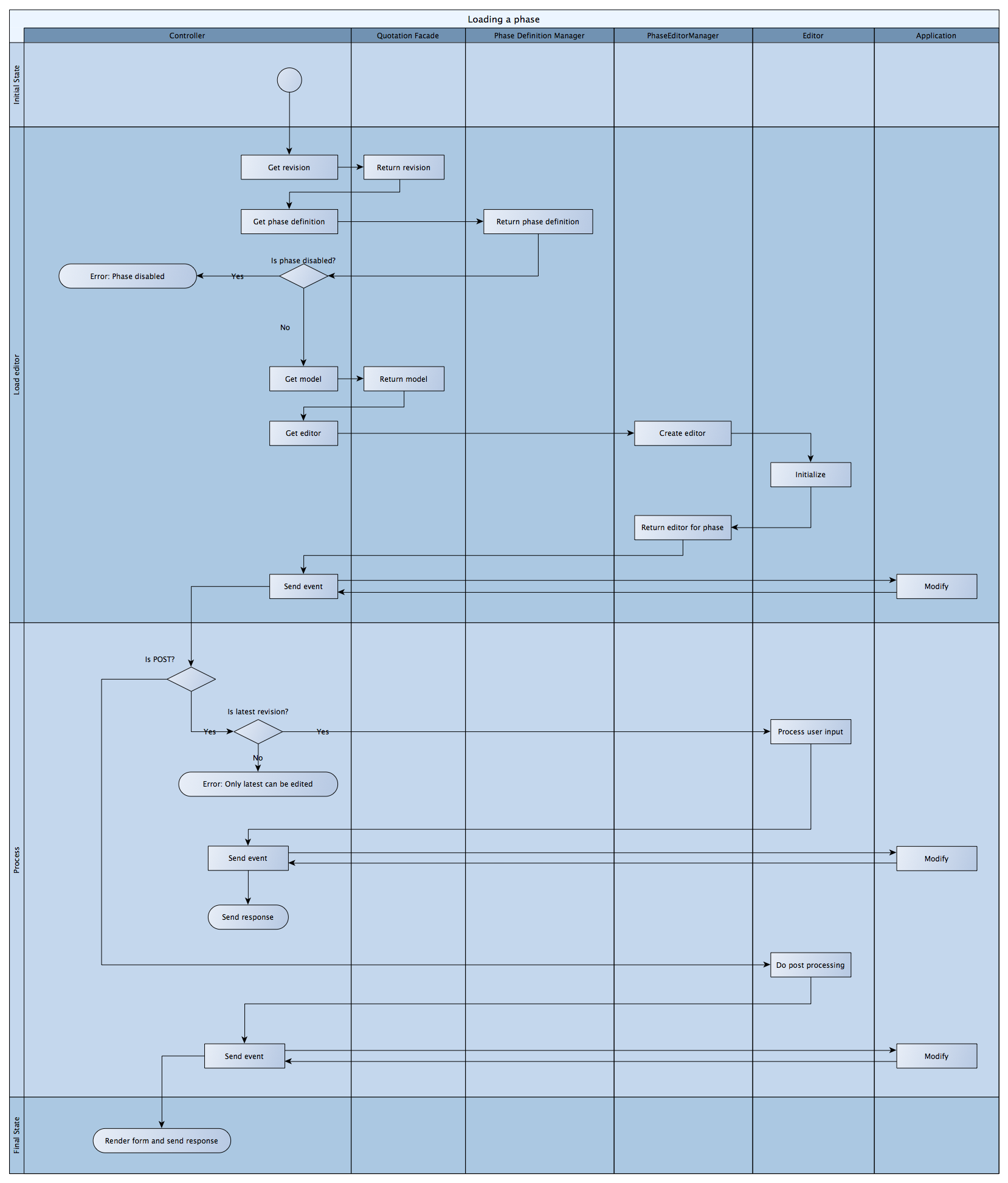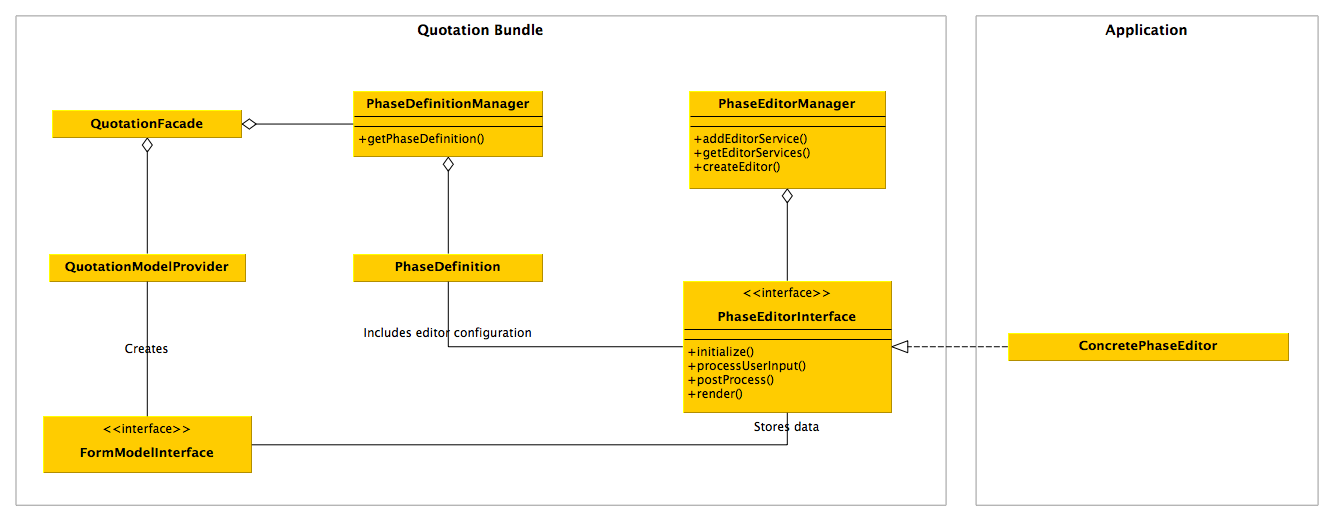Form Phase Definition
Introduction
Each configurable product consists of input phases or forms that gather data to be used when building the offering summary. For each phase in the product line configuration, you must create a YAML file that defines the phase config for that phase.
Phase definition config
Each phase file must define a phaseDefinition array. The configuration is designed to be to used with the Phase Form Editor but you can define custom editors as well. In those cases defining items in the config file might not make sense.
Here it is assumed that the phase form editor is being used to input phase data.
| Option | Type | Required | Notes |
|---|---|---|---|
| title | string | yes | Phase title |
| extends | string | no | Parent phase file definition. Values are taken from the extended file and merged with the values in the current file. See "Inheritance" below. |
| use | array | no | List of namespace shortcuts. See "Namespace Shortcuts" below. |
| model | string | no | Name of the model to which the form fields refer |
| icon | string | no | Font icon name |
| repeat | int/condition | no | Number of times this phase should be repeated. This value can depend on another model field, making it dynamic. |
| lockable | boolean/condition | no | Allow locking of of phase and selected fields. If phase is lockable then the fields with attribute locked are highlighted with a "required" icon. Also, the summary is not shown until all lockable phases are locked. Locking can be defined as condition based on other models' data. |
| disabled | boolean/condition | no | Allow a phase to be disabled with true/false or condition. Disabling a phase prevents access to it but it is still shown in the menu as a disabled option. |
| phases | array | no | List of subphases which are show as tabs inside this phase. Consists of key-value pairs where the array key defines the id of the phase and the value provides the path to the phase definition file (similar to product line config). See "Subphases" below. |
| items | array | yes | List of editable form fields. |
| template | string | no | Override the default phase template, eg. AcmeBundle:Controller:phaseParallel |
| editor | string | no | Defines the editor for this phase, which by default the phase form editor (phase). See the phase form editor config for more details. |
| ordering | array | no | A list of keys that are also defined in the items array. If present, the keys are used to filter the items array and order the items array. This is useful if you extend another config and want to reorder the items array (or leave some items out). |
Extending phases
You can extend the phase from another by giving the parent phase path in the extends parameter. For example, assuming there is a file called parent.yml with content like this:
phaseDefinition:
title: Parent Phase
icon: arrow
lockable: false
items:
first:
text: "First field"
type: text
second:
text: "Second field"
type: text
And another:
phaseDefinition:
title: Child Phase
extends: /path/to/parent/parent.yml
lockable: true
items:
third:
text: "Third field"
type: text
Then the resulting phase config will look like this:
phaseDefinition:
title: Child Phase
icon: arrow
lockable: true
items:
first:
text: "First field"
type: text
second:
text: "Second field"
type: text
third:
text: "Third field"
type: text
The phase parameters which exist in the parent phase are preserved unless overridden in the child. In the above example, the lockable property is true because it is overridden in the child.
Items are combined. To hide an item from the parent in the child phase, set its key to null like this:
phaseDefinition:
title: Child Phase
extends: /path/to/parent/parent.yml
lockable: true
items:
second: ~
third:
text: "Third field"
type: text
This would only show the fields "First field" and "Third field" in the resulting page.
Ordering Items
You can control the ordering of items with the ordering parameter. This is mainly useful if you are extending from another phase file config and want to control the order in which the items are shown. The values refer to the keys that are defined in the items array.
phaseDefinition:
title: Child Phase
extends: /path/to/parent/parent.yml
lockable: true
items:
third:
text: "Third field"
type: text
ordering:
- third
- first
- second
This will show the fields in order: "Third field", "First field" and "Second field".
Namespace Shortcuts
Models for phases are searched by their name with events (see Events). The surrounding app is responsible for instantiating models based on the names defined in the phase definition config. Eg. for a phase with model name "General", a corresponding model should be returned.
The model name may also be a complete path with namespace which might help with finding the correct model. However, typing the full namespace every time is tedious. With the use parameter, you can define shortcuts that are replaced with the corresponding value from the use array.
For example if there are these shortcuts defined:
phaseDefinition:
use:
General: Acme\SomeBundle\Entity\General
Delivery: Acme\SomeBundle\Entity\Delivery
model: General
In this case, when searching for the phase model ("General"), the value is replaced with the entry from the use array ("Acme\SomeBundle\Entity\General").
Subphases
An example of a phase definition config might look like this:
# phaseFile.yml
phaseDefinition:
title: Phase title
model: SomeModelName
icon: list
repeat: "models.SomeOtherModelName.NumberOfPhases"
lockable: true
items:
To configure subphases, set the sub phase paths under phaseDefinition.phases. The path should be the full path to the file in respect to the project root folder.
# phaseFile.yml
phaseDefinition:
title: Phase title
model: SomeModelName
icon: list
phases:
subPhase1: src/OSC/FlotationBundle/Resources/data/phases/subPhase/subPhase1.yml
subPhase2: src/OSC/FlotationBundle/Resources/data/phases/subPhase/subPhase2.yml
subPhase3: src/OSC/FlotationBundle/Resources/data/phases/subPhase/subPhase2.yml
Subphases are then shown as tabs in the main phase. The main phase does not have any content but the first subphase becomes the content shown when accessing the main phase page.
If subphases are not defined, the editor fields must be defined under phaseDefinition.items. Editor items are array nodes under items. The index of each form element must be unique. Eg.:
# phaseFile.yml
phaseDefinition:
items:
sample:
...
anotherField:
...
The exact definition depends on the editor being used. See the configuration options for each editor separately. By default, only the phase form editor is available. To enable custom editors in your project, see "Phase Editors" in Extending Services.
Loading the editor
Below is what happens when the phase is loaded in the controller.

Below is the class diagram for the phase editor and related classes.

Editor Services
It is possible to implement a custom editor to edit a phase. The default editor is the Phase Form Editor whose type is phase. To use a different editor, set the editor property in the phase file configuration.
Editors can add by creating a service and tagging it with the name klaro_quotation.phase_editor. The editor should implement the interface in Klaro\QuotationBundle\Api\PhaseEditorInterface.
Phase Form Editor
See the Phase form editor for usage.